Ecommerce business models of all types are thriving. Sales from online stores are expected to increase 385% this decade.
It’s easy to get caught up and excited in the latest ecommerce trends, but unless you know the fundamentals, you’ll hit a profitability wall without knowing it.
A booming ecommerce business takes intuition, knowledge of your market, a solid business plan, and careful research into products and business models. But one of the biggest hurdles most newcomers to the space face is easy to solve. Many would-be ecommerce business owners just don’t know how ecommerce businesses are set up and what different types of ecommerce are available to them.
If you want to ease into an ecommerce juggernaut, I’d suggest you start a hybrid ecommerce, affiliate store. More on that later.
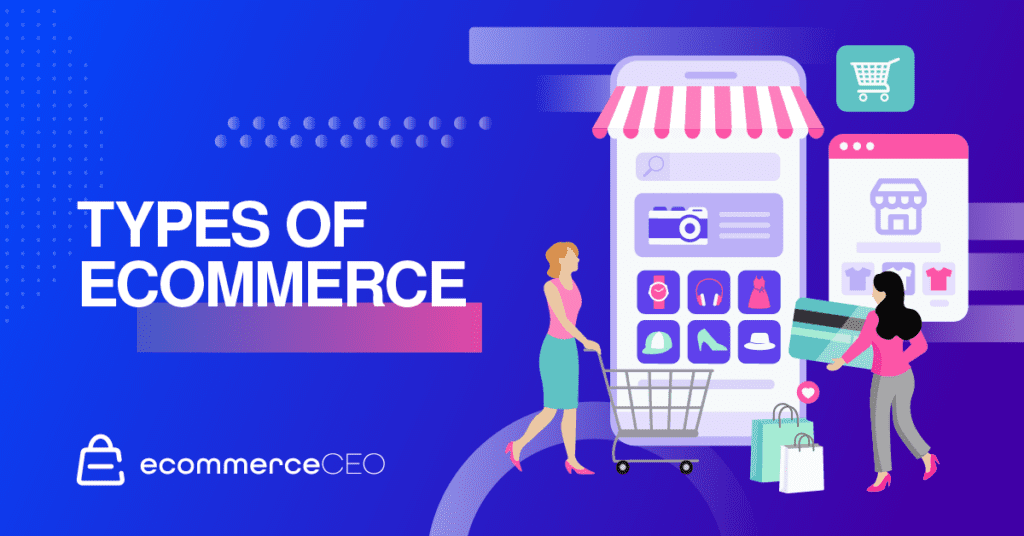
You’ll need to familiarize yourself with each type of ecommerce model before you start your ecommerce business:
You’ll also need to identify an ecommerce platform that suits your preferred business model’s needs. In this post, I’ll walk you through the jargon.
Major Ecommerce Business Classifications
Electronic commerce encompasses all online marketplaces that connect buyers and sellers. The internet is used to process all electronic transactions.
The first thing to think about is the type of business transaction you’re going for. When you think about how you want to sell online, who do you see yourself selling to? Is your business B2B, B2C, C2C, or C2B?
Do you have an idea for a type of ecommerce business that you’ve been thinking about for a while? Do those acronyms make your head spin? Let’s take a look at the most common ways online transactions occur or you can check out a ton of these ecommerce business examples to understand the type of business you’re going after.
B2B: Business to Business Ecommerce
A business-to-business (B2B) model focuses on providing products from one business to another. While many ecommerce sites in this niche are service providers, you’ll find software companies, office furniture and supply companies, document hosting companies, and numerous other ecommerce business models under this heading.
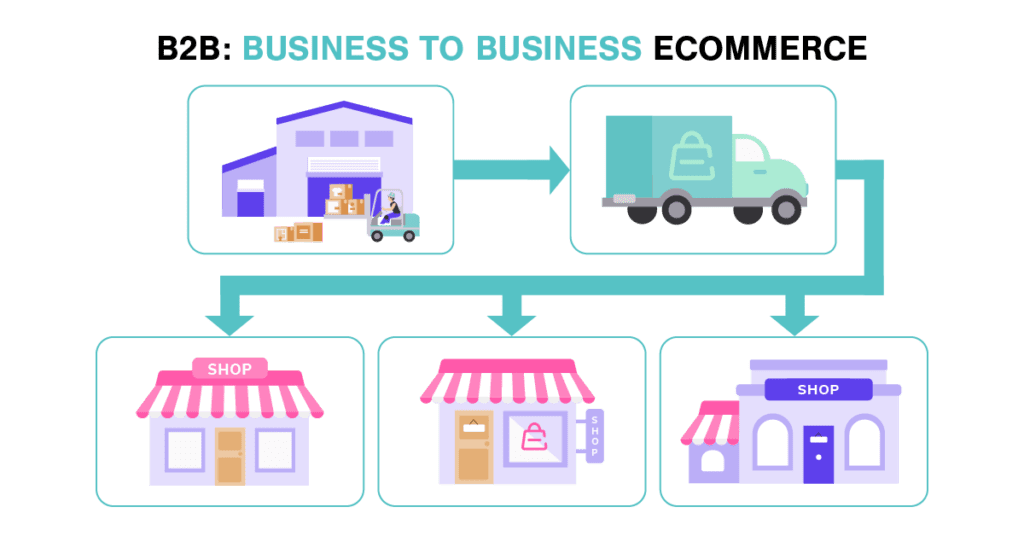
B2B ecommerce examples you may be familiar with include the ExxonMobil Corporation and the Chevron Corporation, Boeing, and Archer Daniel Midlands. These businesses have custom, enterprise ecommerce platforms that work directly with other businesses in a closed environment. A B2B ecommerce business typically requires more startup cash.
B2C: Business to Consumer Ecommerce
The B2C sector is what most people think of when they imagine an ecommerce business. This is the deepest market, and many of the names you’ll see here are known quantities offline, too. B2C ecommerce sales are the traditional retail model, where a business sells to individual online shoppers, but buying is conducted online as opposed to in a physical store.
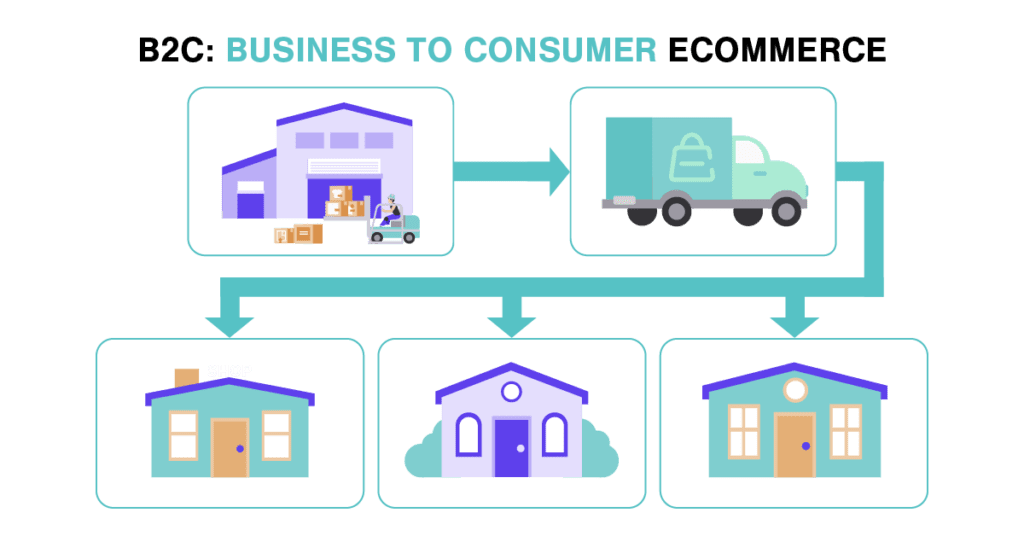
Examples of B2C businesses are everywhere. Exclusively online retailers include Newegg.com, Overstock.com, Wish, and ModCloth, but other major B2C model brick-and-mortar businesses like Staples, Wal-Mart, Target, REI, and Gap.
C2C Ecommerce
B2B and B2C are fairly intuitive concepts for most of us, but the idea of C2C is different. What does a consumer-to-consumer ecommerce business look like?
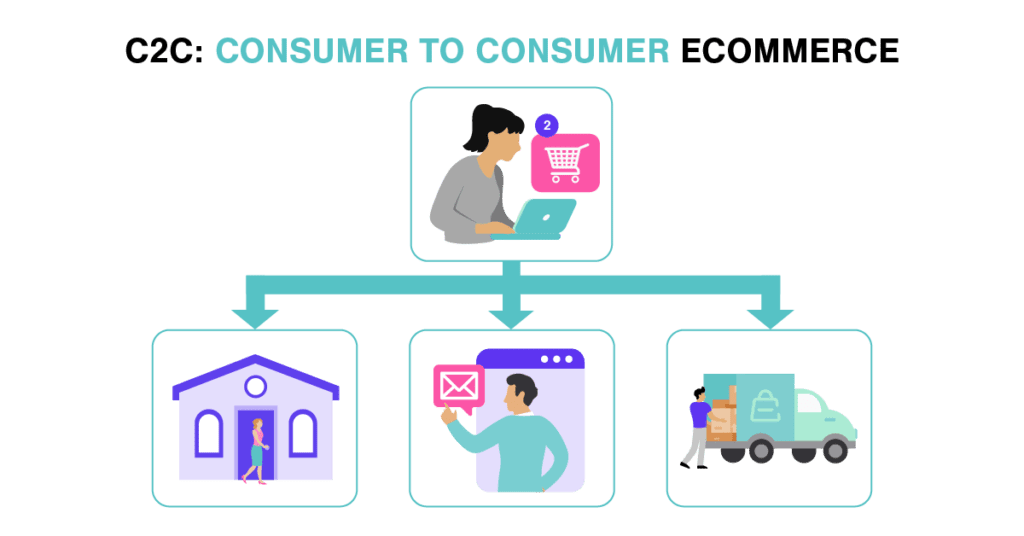
Created by the rise of the ecommerce sector and growing consumer confidence in online business, these ecommerce websites allow customers to trade, buy, and sell items in exchange for a small commission paid to the site. Opening a C2C site takes careful planning.
Despite the obvious success of platforms like eBay and Craigslist, numerous other auction and classified sites (the main arenas for C2C) have opened and quickly closed due to unsustainable models.
C2B: Consumer to Business Ecommerce
C2B is another model most people don’t immediately think of, but that is growing in prevalence. This online shopping business is when the consumer sells goods or services to businesses, and is roughly equivalent to a sole proprietorship serving a larger business.
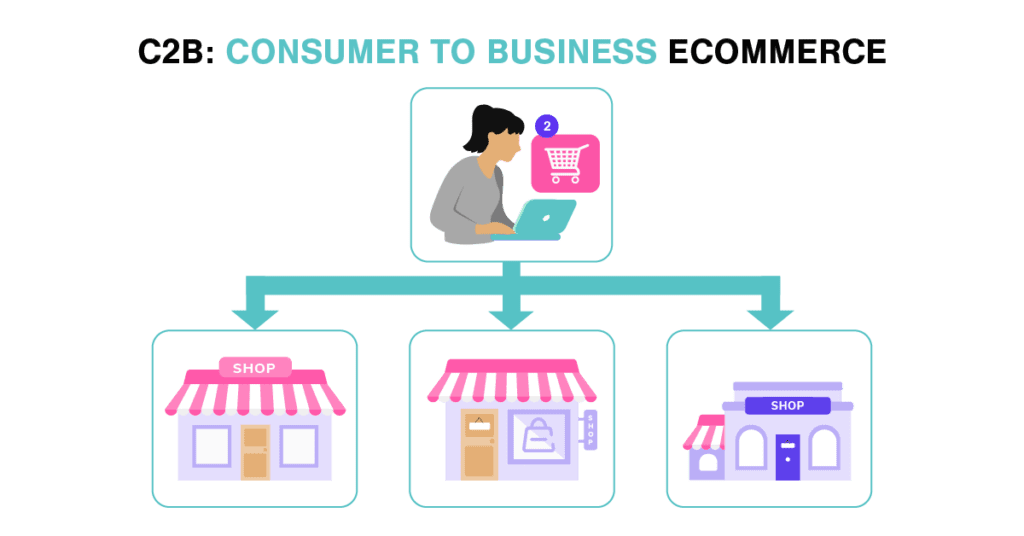
Reverse auctions, service provision sites like UpWork, and several common blog monetization strategies like affiliate marketing or Google AdSense also fall under this heading.
Government / Public Administration Ecommerce
The models listed above are the primary ecommerce retail structures, but they aren’t the only ones. Other types involve government/public administration conducting transactions with businesses or consumers.
- B2G (also called B2A), for businesses whose sole clients are governments or type of public administration. One example is Synergetics Inc. in Ft. Collins, Colorado, which provides contractors and services for government agencies.
- C2G (also called C2A): typically individuals paying the government for taxes or tuition to universities.
Two sectors that are closed for entrepreneur owners but are growing include G2B for government sales to private businesses, and G2C, for government sales to the general public.
Types Of Ecommerce Business Revenue Models
The next most important thing to think about is how you want to handle inventory management and sourcing products. Some people like the idea of making their own products and others hate the idea of their garage full of boxes.
1. Dropshipping
The simplest form of ecommerce, drop shipping lets you set up a storefront and take the customers’ money through credit cards or PayPal. The rest is up to your supplier. This frees you from managing inventory, warehousing stock, or dealing with packaging, but there are disadvantages. For example, quality control.

If your sellers are slow, product quality is lower than expected, or there are problems with the order, it’s on your head (and in your reviews).
Many dropshippers use Shopify and Spocket. Its quick and inexpensive to set up. A popular model is to set up a quick store and drive traffic with Facebook Ads. Margins are thin and if you can squeeze out some profit here, more power to you. I’m holding off on drop shipping for now, but you can make money with it.
2. Wholesaling and Warehousing
Wholesaling and warehousing ecommerce businesses require a lot of investment at the start – you need to manage inventory and stock, keep track of customer orders and shipping information, and invest in the warehouse space itself.

DollarDays is an online wholesaler with a massive product catalog that includes more than 260,000 products. They employ a key strategy for retailers in this space – by offering case prices AND piece prices, they can sell to the general public and to retailers. This gives them a higher profit margin than a strictly wholesale model.
Solutions For Wholesalers
Wholesale businesses are all about volume. You’ll need to push products out to eBay, Amazon, Google, etc. BigCommerce includes all this in their Basic plan for $29 month. No tinkering needed. If you have dev skills, you can use X-Cart.
3. Private Labeling and Manufacturing
If you’ve got an idea for the perfect product, but don’t have the cash or desire to build your own factory, this might be the right business model for you. Companies that manufacture products offsite for sale send the plans or prototypes to a contracted manufacturer who produces the product to meet customer specifications and can either ship directly to the consumer, to a third party such as Amazon, or to the company selling the final product.
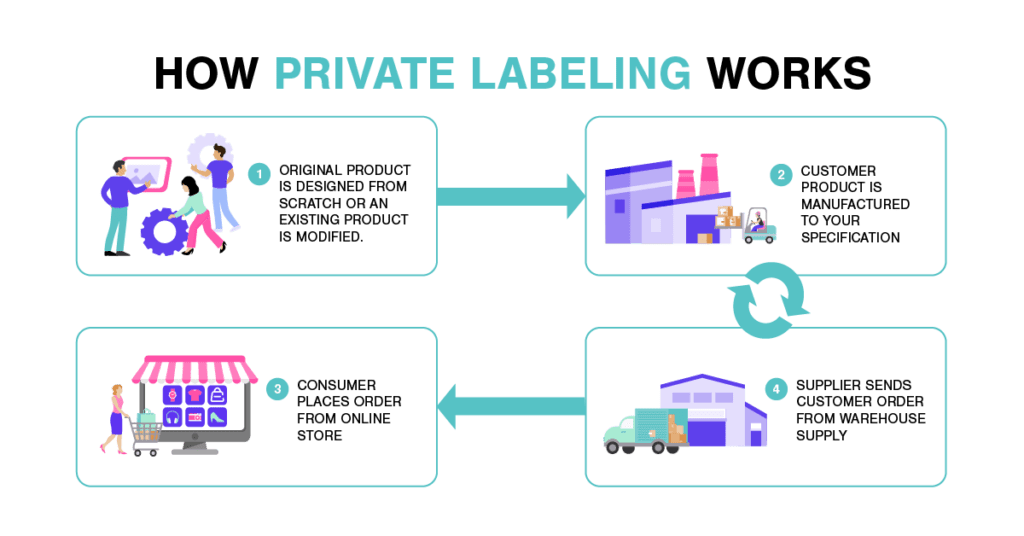
On-demand manufacturing allows you to quickly change suppliers if you encounter problems with product quality. The startup costs are minimal, and if you’re interested in potentially opening your own production facilities later, this is a good way to test a new product or concept.
- The Complete Guide To Finding The Best Private Label Manufacturers
- 29 Private Label Product Ideas to Kickstart a $100K+ Brand
4. White Labeling
White labeling is similar. You choose a product that is already successfully sold by another company, but offers white label options, design your package and label, and sell the product. This is common in the beauty and wellness industries, but more difficult to encounter in other niches.

One problem with white labeling is demand. You’re stuck with whatever you order, and most of these companies set a minimum production quantity. If you can’t sell it, you’ll have to live with it. Consider this option when you’re willing to work full time on your business and know your product is in demand.
A common type of white labeling is Print On Demand. Read more about how to start a print on demand business.
5. Subscription
One of the most popular and successful pure ecommerce brands is the Dollar Shave Club. Other examples of subscription services include Stitch Fix, Blue Apron, and Nature Box. On the local level, community-supported agriculture boxes are popular.
These companies rely on a subscription model that delivers customers a box of products at regular, scheduled intervals. Subscription companies have relatively reliable income streams and can easily incentivize customers to purchase additional subscriptions or encourage their contacts to subscribe.
Picking the right products and niches can be difficult. Successful subscription boxes tend to fall into a small handful of product categories: health and grooming, beauty, fashion, and food. Outside of these areas, few subscription companies thrive.
Recurring Online Billing Software
I love the idea of a subscription based e-commerce model. Both Shopify and BigCommerce need additional, paid apps for subscription based ecommerce. So you’ll need something like WooCommerce Subscriptions (WordPress) or X-Cart to handle this.
Must Read:
- 21 Product Research Tips To Uncover Legit Ecommerce Market Opportunities
- How To Start Your Own Clothing Line (Tips From 14 Fashion Pros)
- How to Sell Your Successful Ecommerce Business
- How to Sell A Shopify Store (Free Guide)
What Model Fits Your Idea Best?
Now that you know what ecommerce businesses, product options, platforms, and business classifications exist, you’re ready to get started. Take a look at your business plan.
No matter what eCommerce business model you choose, chances are you are going to need outside funding at some point in order to scale your business. Funding solutions like Payability specialize in eCommerce businesses and offer both accelerated daily payouts when marketplaces pay on terms and capital advances based on future eCommerce sales.
If you found this article useful, please give it a share. Keep reading the Ecommerce CEO blog for tips to help you succeed in ecommerce, from choosing your online platform to marketing your products and site. Maybe you want to know how to find your niche.
If there’s a topic you would like to see covered that you don’t see in our archives, leave a comment below.









